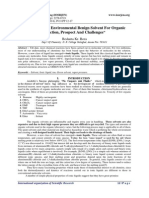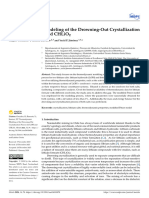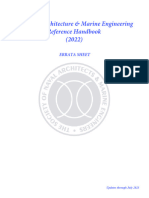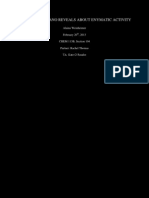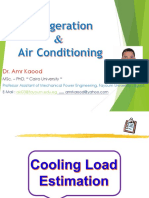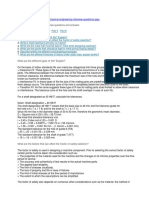Introduction: Ionic Liquids: Editorial
Introduction: Ionic Liquids: Editorial
Uploaded by
bala11ap4598Copyright:
Available Formats
Introduction: Ionic Liquids: Editorial
Introduction: Ionic Liquids: Editorial
Uploaded by
bala11ap4598Original Title
Copyright
Available Formats
Share this document
Did you find this document useful?
Is this content inappropriate?
Copyright:
Available Formats
Introduction: Ionic Liquids: Editorial
Introduction: Ionic Liquids: Editorial
Uploaded by
bala11ap4598Copyright:
Available Formats
Editorial
pubs.acs.org/CR
Introduction: Ionic Liquids
I onic liquids (ILs) are normally dened as compounds
completely composed of ions with melting point below 100
C. The rst IL (ethylammonium nitrate) was reported by Paul
ranging from the molecular level to the industrial level. The
popular multiscale method originating from other disciplines
was extended to IL systems. Furthermore, Izgorodina, Seeger,
Walden in 1914, who at that time never realized that ILs would Scarborough, and Tan17 give an overview on how to predict the
become a major scientic area after almost one century. energetic, physical, and spectroscopic properties of ILs by
Actually, ILs as innovative uids have received wide attention means of quantum chemical methods and empirical ap-
only during the past two decades. The number of SCI papers proaches. Among others, the COSMO-RS (conductor-like
published on ILs has exponentially increased from a few in screening model for real solvents) model, which is an a priori
1996 to >5000 in 2016, exceeding the annual growth rates of predictive model, is the most widely used in the IL community,
other popular scientic areas. This indicates that more and enabling theoretical calculations to decrease the amount of
more researchers are engaged in studying this exciting area, required experimental work. Zhang, Zhang, Zhang, and Deng18
with the outcomes being plentiful. A multidisciplinary study on focus on the nanoconned scale in ILs and the interactions
ILs is emerging, including chemistry, materials science, between ILs and the pore walls inside porous materials; this
chemical engineering, and environmental science. More brings to the ILs distinctly modied physicochemical properties
specically, some important fundamental viewpoints are now when compared to the corresponding bulk liquid. The potential
dierent from the original concepts, as insights into the nature applications of nanoconned ILs in catalysis, separation,
of ILs become deeper. For example, the physicochemical ionogels, supercapacitors, carbonization, and lubrication are
properties of ILs are now recognized as ranging broadly from thoroughly reviewed.
the oft quoted nonvolatile, non-ammable, and air and water In many chemical reaction processes, ILs are suggested as
stable to those that are distinctly volatile, ammable, and solvents, catalysts, reagents, or combinations of these. Zhang,
unstable. This is attributed to numerous combinations of Song, and Han19 provide a comprehensive review on the
cations and anions that meet the denition of ILs, leading to a catalytic conversion of cellulose, hemicellulose, lignin, and
diverse suite of behaviors. Regardless, ILs remain more lignocellulosic biomass into value-added chemicals and fuel
desirable than conventional volatile solvents and/or catalysts products, in which ILs act as the solvents or as IL-based
in many physical and chemical processes, often exhibiting catalysts. Various useful products can be obtained through
green and designer properties to a useful degree. lignocellulose valorization using ILs. Qiao, Ma, Theyssen,
As their chemical variety has grown, ILs have been further Chen, and Hou20 discuss an interesting family of ILs, i.e.
divided into many types, e.g., room-temperature ILs temperature-responsive ILs, which are used for the thermo-
(RTILs),16 task-specic ILs (TSILs),7,8 polyionic liquids regulated catalytic systems, such as hydroformylation, reduction
with H2 or CO, and coupling reactions. The working principle
(PILs),9,10 and supported IL membranes (SILMs)11,12 that
is that this type of IL can form a homogeneous mixture with the
include composites of ILs supported on metalorganic
reactants and products, but be separated from them readily
frameworks (MOFs).13,14 The hybrid organicionic nature of
when the reaction conditions are changed. From the viewpoint
ILs and the resulting intermolecular interactions give rise to a
of chemical engineering, the most important advantage is that
complex set of phenomena, creating an area of study that is
the gas/liquidsolid mass transfer limitations, which may be
both fascinating and challenging. Scientists and engineers are the rate-determining step in many catalytic transformations, can
often required to screen for suitable ILs quickly for a specic be overcome. Dai, Zhang, Huang, and Lei21 provide a detailed
process. For this purpose, the identication of structure review of ILs in several important and typical selective
performance relationships disclosing the interplay among ILs, oxidation reactions. ILs are preferable in this context as highly
solutes, supports, and the components in mixtures becomes ecient catalysts and innovative green solvents due to their
vital, requiring a close integration of experimental, theoretical, unique physical properties, including their nonvolatility,
and computational methods. Thus, it is necessary to collect our reaction rate acceleration eects, and high thermal stability.
recent ndings in this area and summarize the governing rules In particular, their use as biphasic catalysts, or immobilized
behind these complex phenomena. This compelled us to invite catalysts obtained by immobilizing metal- or nonmetal-
a number of prestigious scientists to contribute to this thematic containing ILs onto mineral or polymer supports, is highlighted
issue on ILs for Chemical Reviews. We should mention that in detail.
deep eutectic solvents (DESs) are not highlighted in this In separation processes, the selection of suitable solvents (or
thematic issue because DESs and ILs form two quite dierent separating agents) is a key for targeted process intensication.
solvent families. For more detail on DESs, please see the Ventura, e Silva, Quental, Mondal, Freire, and Coutinho22 oer
excellent review written by Smith, Abbott, and Ryder.15 a detailed review on the use of ILs as solvents in the extraction
This issue covers a range of dierent aspects of ILs, and/or purication of bioactive compounds, ranging from small
beginning with the multiscale science of ILs. It is evident that a organic compounds to more complex molecules. Dierent IL-
better understanding of IL behavior at the microscopic scale
will help to elucidate macroscopic uid phenomena, and thus
Special Issue: Ionic Liquids
promote the industrial application of ILs. Dong, Liu, Dong,
Zhang, and Zhang16 discuss the multiscale aspects of ILs, Published: May 24, 2017
2017 American Chemical Society 6633 DOI: 10.1021/acs.chemrev.7b00246
Chem. Rev. 2017, 117, 66336635
Chemical Reviews Editorial
based extraction processes are addressed, including liquid Douglas R. MacFarlane
liquid extraction, solidliquid extraction, solid-phase extraction, School of Chemistry, Monash University, Australia
and induced-precipitation techniques. The use of ILs can bring
about higher extraction yields and purication factors when AUTHOR INFORMATION
compared to conventional solvents and materials.
Corresponding Author
The progress in IL science is closely related to the
development of characterization techniques. Infrared (IR) and *E-mail: leizhg@mail.buct.edu.cn.
Raman spectroscopies have proven to provide exceptional ORCID
fundamental insight into ionic interactions and the resulting
Zhigang Lei: 0000-0001-7838-7207
liquid structure in ILs. Paschoal, Faria, and Ribeiro23 discuss the
application of IR and Raman spectroscopies in the mid- and Notes
low-frequency range in the bulk liquid, as well as in Views expressed in this editorial are those of the authors and
understanding the structural modications of ILs accompanying not necessarily the views of the ACS.
phase transitions induced by variable temperature or pressure.
Biographies
To the best of our knowledge, it is the rst review on this topic,
and we expect that many scientists and engineers will nd it to Zhigang Lei is a professor at the State Key Laboratory of Chemical
be a useful resource. Resource Engineering at Beijing University of Chemical Technology,
Are ILs chemically stable? This topic is very important to China. He received his B.S. degree in 1995 from Wuhan Institute of
ensure that potential industrial application of ILs becomes a Technology, and his Ph.D. degree in 2000 from Tsinghua University.
reality. The review by Wang, Qin, Mu, Xue, and Gao24 covers Then, he became a postdoctoral researcher at Beijing University of
the chemical stability and reactivity of popular imidazolium- Chemical Technology, working with Professor Chengyue Li. In 2003
based ILs, including thermal decomposition, hydrolysis, and 2005, he worked as a researcher at the Research Center of Supercritical
nucleophilic reactions of anions under actual operating Fluid Technology (Tohoku University, Sendai, Japan). In 20052006,
conditions (e.g., high temperature, and the presence of water, he received the world-famous Humboldt Fellowship and carried out
air, or other gases). Thus, this review will provide a guide for his research as Chair of Separation Science and Technology
further industrial application of ILs. (Universitat Erlange-Nurnberg, Erlangen, Germany). In 2006, he
Two reviews in this issue deal with innovative applications of came back to Beijing University of Chemical Technology. His current
ILs in emerging areas. Egorova, Gordeev, and Ananikov25 research interests include chemical process intensication and
discuss the biological activity of ILs and their applications in predictive molecular thermodynamics. He has contributed to about
drug synthesis and drug delivery systems, with a particular 120 papers in international journals and one book entitled Special
emphasis on a novel active pharmaceutical ingredientionic Distillation Processes, published by Elsevier B.V. (2005).
liquid (APIL-IL) concept. In these cases, ILs are utilized as Biaohua Chen is a professor at the State Key Laboratory of Chemical
components of drug or drug delivery systems, and in the dual Resource Engineering at Beijing University of Chemical Technology,
roles of reaction media and catalysts in drug synthesis. In an China. He received his Ph.D. degree in 1996 from China University of
entirely dierent area, Watanabe, Thomas, Zhang, Ueno, Petroleum (Beijing). In 2000, he was a visiting scholar at Washington
Yasuda, and Dokko26 discuss the application of ILs in energy University in St. Louis and the University of Washington. He has
storage and conversion materials and devices. They review the received two National Science and Technology Progress Prizes
use of ILs as electrolyte materials for Li/Na ion, Li/S, and Li/ (second class), two provincial or ministerial level Science and
O2 batteries, fuel cell electrolytes, and electrode materials, Technology Progress Prizes (rst class), and one Natural Science
especially those including ionic-liquid-derived N-doped car- Progress Prize. Now he is a member of the Standing Committee of the
bons. Some ILs can meet the stringent criteria imposed by Beijing Chemical Industry Association and a member of the Editorial
various energy applications due to their unique properties, Board of the Journal of Petrochemical Universities (China). His main
including nonammability, high electrochemical stability, and research interests are green chemistry and environmental catalysis. He
high ionic conductivity. has contributed to more than 150 papers in international journals.
Finally, we would like to thank all the authors for their
Yoon-Mo Koo is a Professor at the Department of Biological
excellent contributions to this thematic issue. We also thank the
Engineering at Inha University, Korea. He received a B.S. degree
editorial sta of Chemical Reviews for their valuable suggestions
(Seoul National University, Korea), an M.S. degree (KAIST, Korea)
in initiating the thematic issue, as well as their hard work in
and a Ph.D. degree (Purdue University, USA), all in Chemical
handling the manuscripts. We hope that young scientists and
Engineering. He served as the Dean of College of Engineering, Inha
students who are engaged in studying this exciting area can
University, and as the President of Korean Society of Biotechnology
benet signicantly from the publication of this collection of
and Bioengineering, and he is currently a Member of the National
reviews and thereby make further important progress in the
Academy of Engineering, Korea. His research interests include
eld. biological separation and purication, microbial mixed culture, and
Zhigang Lei* ionic liquids. He has contributed to more than 140 papers in
State Key Laboratory of Chemical Resource Engineering, international journals. He was the organizing committee chairman of
Beijing University of Chemical Technology, China the 6th International Congress on Ionic Liquids (COIL-6), held on
Biaohua Chen June 1620, 2015, in Jeju, Korea.
State Key Laboratory of Chemical Resource Engineering, Douglas R. MacFarlane is an Australian Laureate Fellow at Monash
Beijing University of Chemical Technology, China University. He is also the program leader of the Energy Program at the
Yoon-Mo Koo Australian Centre for Electromaterials Science. His research interests
Department of Biological Engineering, Inha University, focus on a broad range of ionic liquid properties and applications. He
Korea was a Ph.D. graduate from Austen Angells group at Purdue and after
6634 DOI: 10.1021/acs.chemrev.7b00246
Chem. Rev. 2017, 117, 66336635
Chemical Reviews Editorial
postdoctoral fellowships in France and New Zealand took up an (20) Qiao, Y.; Ma, W.; Theyssen, N.; Chen, C.; Hou, Z.
academic position at Monash in 1983. He has published more than Temperature-Responsive Ionic Liquids: Fundamental Behaviors and
600 papers and 30 patents. He was elected to the Australian Academy Catalytic Applications. Chem. Rev. 2017, DOI: 10.1021/acs.chem-
rev.6b00652.
of Sciences in 2007 and to the Australian Academy of Technological
(21) Dai, C.; Zhang, J.; Huang, C.; Lei, Z. Ionic Liquids in Selective
Sciences and Engineering in 2009. Oxidation: Catalysts and Solvents. Chem. Rev. 2017, DOI: 10.1021/
acs.chemrev.7b00030.
REFERENCES (22) Ventura, S. P. M.; e Silva, F. A.; Quental, M. V.; Mondal, D.;
Freire, M. G.; Coutinho, J. A. P. Ionic-Liquid-Mediated Extraction and
(1) Hallett, J. P.; Welton, T. Room-Temperature Ionic Liquids: Separation Processes for Bioactive Compounds: Past, Present, and
Solvents for Synthesis and Catalysis. 2. Chem. Rev. 2011, 111, 3508 Future Trends. Chem. Rev. 2017, DOI: 10.1021/acs.chemrev.6b00550.
3576. (23) Paschoal, V. H.; Faria, L. F. O.; Ribeiro, M. C. C. Vibrational
(2) Bara, J. E.; Carlisle, T. K.; Gabriel, C. J.; Camper, D.; Finotello, Spectroscopy of Ionic Liquids. Chem. Rev. 2017, DOI: 10.1021/
A.; Gin, D. L.; Nobel, R. D. Guide to CO2 Separations in Imidazolium- acs.chemrev.6b00461.
Based Room-Temperature Ionic Liquids. Ind. Eng. Chem. Res. 2009, (24) Wang, B.; Qin, L.; Mu, T.; Xue, Z.; Gao, G. Are Ionic Liquids
48, 27392751. Chemically Stable? Chem. Rev. 2017, DOI: 10.1021/acs.chem-
(3) Lei, Z.; Dai, C.; Chen, B. Gas Solubility in Ionic Liquid. Chem. rev.6b00594.
Rev. 2014, 114, 12891326. (25) Egorova, K. S.; Gordeev, E. G.; Ananikov, V. P. Biological
(4) Lei, Z.; Dai, C.; Zhu, J.; Chen, B. Extractive Distillation with Ionic Activity of Ionic Liquids and Their Application in Pharmaceutics and
Liquids: A Review. AIChE J. 2014, 60, 33123329. Medicine. Chem. Rev. 2017, DOI: 10.1021/acs.chemrev.6b00562.
(5) Chatel, G.; MacFarlane, D. R. Ionic Liquids and Ultrasound in (26) Watanabe, M.; Thomas, M. L.; Zhang, S.; Ueno, K.; Yasuda, T.;
Combination: Synergies and Challenges. Chem. Soc. Rev. 2014, 43, Dokko, K. Application of Ionic Liquids to Energy Storage and
81328149. Conversion Materials and Devices. Chem. Rev. 2017, DOI: 10.1021/
(6) Mai, N. L.; Koo, Y. M. Computer-Aided Design of Ionic Liquids acs.chemrev.6b00504.
for High Cellulose Dissolution. ACS Sustainable Chem. Eng. 2016, 4,
541547.
(7) Gurkan, B. E.; de la Fuente, J.; Mindrup, E. M.; Ficke, L. E.;
Goodrich, B. F.; Price, E. A.; Schneider, W. F.; Brennecke, J. F.
Equimolar CO2 Absorption by Anion-Functionalized Ionic Liquids. J.
Am. Chem. Soc. 2010, 132, 21162117.
(8) Ruckart, K. N.; OBrien, R. A.; Woodard, S. M.; West, K. N.;
Grant, T. Glover Porous Solids Impregnated with Task-Specific Ionic
Liquids as Composite Sorbents. J. Phys. Chem. C 2015, 119, 20681
20697.
(9) Qian, W.; Texter, J.; Yan, F. Frontiers in Poly(ionic liquid)s:
Syntheses and Applications. Chem. Soc. Rev. 2017, 46, 11241159.
(10) Rojas, M. F.; Bernard, F. L.; Aquino, A.; Borges, J.; Dalla
Vecchia, F.; Menezes, S.; Ligabue, R.; Einloft, S. Poly(ionic liquid)s as
Efficient Catalyst in Transformation of CO2 to Cyclic Carbonate. J.
Mol. Catal. A: Chem. 2014, 392, 8388.
(11) Wickramanayake, S.; Hopkinson, D.; Myers, C.; Hong, L.; Feng,
J.; Seol, Y.; Plasynski, D.; Zeh, M.; Luebke, D. Mechanically Robust
Hollow Fiber Supported Ionic Liquid Membranes for CO2 Separation
Applications. J. Membr. Sci. 2014, 470, 5259.
(12) Scovazzo, P.; Havard, D.; McShea, M.; Mixon, S.; Morgan, D.
Long-term, Continuous Mixed-gas Dry Fed CO2/CH4 and CO2/N2
Separation Performance and Selectivities for Room Temperature Ionic
Liquid Membranes. J. Membr. Sci. 2009, 327, 4148.
(13) Khan, N. A.; Hasan, Z.; Jhung, S. H. Ionic Liquids Supported on
Metal-Organic Frameworks: Remarkable Adsorbents for Adsorptive
Desulfurization. Chem. - Eur. J. 2014, 20, 376380.
(14) Vicent-Luna, J. M.; Gutierrez-Sevillano, J. J.; Anta, J. J.; Calero,
S. Effect of Room-Temperature Ionic Liquids on CO2 Separation by a
Cu-BTC MetalOrganic Framework. J. Phys. Chem. C 2013, 117,
2076220768.
(15) Smith, E. L.; Abbott, A. P.; Ryder, K. S. Deep Eutectic Solvents
(DESs) and Their Applications. Chem. Rev. 2014, 114, 1106011082.
(16) Dong, K.; Liu, X.; Dong, H.; Zhang, X.; Zhang, S. Multiscale
Studies on Ionic Liquids. Chem. Rev. 2017, DOI: 10.1021/
acs.chemrev.6b00776.
(17) Izgorodina, E. I.; Seeger, Z. L.; Scarborough, D. L. A.; Tan, S. Y.
S. Quantum Chemical Methods for the Prediction of Energetic,
Physical and Spectroscopic Properties of Ionic Liquids. Chem. Rev.
2017, DOI: 10.1021/acs.chemrev.6b00528.
(18) Zhang, S.; Zhang, J.; Zhang, Y.; Deng, Y. Nanoconfined Ionic
Liquids. Chem. Rev. 2017, DOI: 10.1021/acs.chemrev.6b00509.
(19) Zhang, Z.; Song, J.; Han, B. Catalytic Transformation of
Lignocellulose into Chemicals and Fuel Products in Ionic Liquids.
Chem. Rev. 2017, DOI: 10.1021/acs.chemrev.6b00457.
6635 DOI: 10.1021/acs.chemrev.7b00246
Chem. Rev. 2017, 117, 66336635
You might also like
- Steam SilencerDocument3 pagesSteam SilencerAntonio Perez100% (1)
- Ionic Liquids Synthesis and Applications - An OverviewDocument63 pagesIonic Liquids Synthesis and Applications - An OverviewArdu StuffNo ratings yet
- Ionogels, Ionic Liquid Based Hybrid MaterialsDocument20 pagesIonogels, Ionic Liquid Based Hybrid Materialssaismaran999No ratings yet
- The Art of Using Ionic Liquids in The Synthesis of Inorganic NanomaterialsDocument10 pagesThe Art of Using Ionic Liquids in The Synthesis of Inorganic NanomaterialsAhsan JalalNo ratings yet
- Poly (Ionic Liquid) S: Polymers Expanding Classical Property ProfilesDocument14 pagesPoly (Ionic Liquid) S: Polymers Expanding Classical Property Profilessaismaran999No ratings yet
- Singh.2021.DES Mini ReviewDocument15 pagesSingh.2021.DES Mini ReviewnabilNo ratings yet
- Molecules 14 03780 PDFDocument34 pagesMolecules 14 03780 PDFvrmr84No ratings yet
- Thermodynamics SolubilityDocument9 pagesThermodynamics SolubilityFranciscoNo ratings yet
- Fchem 06 00612Document16 pagesFchem 06 00612DIEGO FERNANDO LLACHE ROBLEDONo ratings yet
- Liu and Maginn - 2011 - A molecular dynamics investigation of the structurDocument17 pagesLiu and Maginn - 2011 - A molecular dynamics investigation of the structurMengyang QuNo ratings yet
- Benimam July 2019Document19 pagesBenimam July 2019Cherif SI MOUSSANo ratings yet
- Ioni LiquidsDocument4 pagesIoni Liquids70154512No ratings yet
- Fchem 08 627213Document3 pagesFchem 08 627213pathakshivam767No ratings yet
- Deep Eutectic Solvents - Syntheses, Properties and ApplicationsDocument39 pagesDeep Eutectic Solvents - Syntheses, Properties and ApplicationsirfanNo ratings yet
- Capítulo de Libro Con DOIDocument23 pagesCapítulo de Libro Con DOIAlejandro Estrella GutiérrezNo ratings yet
- JICS 6 4 Review 1Document32 pagesJICS 6 4 Review 1Valentina BusicNo ratings yet
- 10 1016@j Microc 2020 105539Document7 pages10 1016@j Microc 2020 105539Héctor Gómez YáñezNo ratings yet
- Maginn 2009Document18 pagesMaginn 2009lambdatauphi10No ratings yet
- 6 PDFDocument15 pages6 PDFLuciano Augusto Gerling GarzaNo ratings yet
- Design of Ionic Liquids Containing Glucose and Choline As Drug Carriers, Finding The Link Between QM and MD StudiesDocument25 pagesDesign of Ionic Liquids Containing Glucose and Choline As Drug Carriers, Finding The Link Between QM and MD StudiesSome BodyNo ratings yet
- IJCA 47A(4) 495-503Document9 pagesIJCA 47A(4) 495-503kudupudiruthviksai5No ratings yet
- Ionic Liquids Today - 3-2011Document39 pagesIonic Liquids Today - 3-2011David AntonitoNo ratings yet
- Ionic Liquids-An Overview: Stewart A. Forsyth, Jennifer M. Pringle, and Douglas R. MacfarlaneDocument7 pagesIonic Liquids-An Overview: Stewart A. Forsyth, Jennifer M. Pringle, and Douglas R. Macfarlaneshubhang2392No ratings yet
- Ionic Liquids: Innovative Fluids For Chemical ProcessingDocument6 pagesIonic Liquids: Innovative Fluids For Chemical ProcessingRbeetraekNo ratings yet
- We Are Intechopen, The World'S Leading Publisher of Open Access Books Built by Scientists, For ScientistsDocument37 pagesWe Are Intechopen, The World'S Leading Publisher of Open Access Books Built by Scientists, For ScientistssjonathanpastorNo ratings yet
- Ionic Liquid ApplicationDocument6 pagesIonic Liquid ApplicationManoj Kumar LalNo ratings yet
- C5RA08625FDocument20 pagesC5RA08625FAmisha NaikNo ratings yet
- Hapiot Et Al. - 2013 - Thermoresponsive Hydrogels in CatalysisDocument5 pagesHapiot Et Al. - 2013 - Thermoresponsive Hydrogels in Catalysisjfjd6889No ratings yet
- Ionic Liquid - Environmental Benign Solvent For Organic Reaction, Prospect and ChallengesDocument6 pagesIonic Liquid - Environmental Benign Solvent For Organic Reaction, Prospect and ChallengesIOSRJEN : hard copy, certificates, Call for Papers 2013, publishing of journalNo ratings yet
- CO2 CaptureDocument11 pagesCO2 CaptureQamir Ullah Khan NiaziNo ratings yet
- Preprints202308 0932 v1Document13 pagesPreprints202308 0932 v1happytolxwNo ratings yet
- ReferensiDocument5 pagesReferensifiqrah lestariNo ratings yet
- Ionic Liquids DissertationDocument6 pagesIonic Liquids DissertationBestOnlinePaperWritersSingapore100% (1)
- Silica-Based Supported Ionic Liquid-Like Phases As Heterogeneous CatalystsDocument34 pagesSilica-Based Supported Ionic Liquid-Like Phases As Heterogeneous CatalystsSome BodyNo ratings yet
- 1 Surfactant Chemistry and General Phase BehaviourDocument10 pages1 Surfactant Chemistry and General Phase BehaviourAnonymous cgKtuWzNo ratings yet
- Ionic LiquidsDocument12 pagesIonic LiquidsCésar Asensy Monter100% (1)
- Advanced Intelligent Systems - 2023 - Kanjilal - Bioionic Liquids Enabling A Paradigm Shift Toward Advanced and SmartDocument22 pagesAdvanced Intelligent Systems - 2023 - Kanjilal - Bioionic Liquids Enabling A Paradigm Shift Toward Advanced and Smarthamza najmNo ratings yet
- Ionic Liquids Recycling For ReuseDocument34 pagesIonic Liquids Recycling For ReusesabueishahNo ratings yet
- Unleashing The Potential of Ionic LiquidsDocument9 pagesUnleashing The Potential of Ionic LiquidsLorena BrownNo ratings yet
- (Faundez-Fierro-Munoz, 2024) Solubility of Methane in ILs For Gas Removal ProcessesDocument15 pages(Faundez-Fierro-Munoz, 2024) Solubility of Methane in ILs For Gas Removal Processeslucas.eq.cardosoNo ratings yet
- Spotlight On Ionic LiquidsDocument10 pagesSpotlight On Ionic Liquidsca_alzuNo ratings yet
- Pharmaceutics 11 00096 v2Document21 pagesPharmaceutics 11 00096 v2Valentina AnutaNo ratings yet
- J5 PDFDocument10 pagesJ5 PDFPhuong Anh TrầnNo ratings yet
- Hosseini RevisedDocument12 pagesHosseini RevisedIman QurbanovNo ratings yet
- aic.15957Document48 pagesaic.15957zuhra hsNo ratings yet
- Chitosan Schiff-Base Hydrogels-A Critical Perspective ReviewDocument11 pagesChitosan Schiff-Base Hydrogels-A Critical Perspective ReviewAlexandraNo ratings yet
- Hybrid Inorganic-Organic Materials by Sol-Gel Processing of Organofunctional Metal AlkoxidesDocument18 pagesHybrid Inorganic-Organic Materials by Sol-Gel Processing of Organofunctional Metal AlkoxidesHéctor MontenegroNo ratings yet
- Review RTILtomweltonDocument69 pagesReview RTILtomweltonMathias Prado100% (1)
- Assignment 03Document6 pagesAssignment 03rehan mughalNo ratings yet
- Journal of Biomedical SciencesDocument37 pagesJournal of Biomedical SciencesumairNo ratings yet
- Metals 14 00078Document13 pagesMetals 14 00078Yahaira Barrueto JhonsonNo ratings yet
- Paper 6Document22 pagesPaper 6reddishchilliNo ratings yet
- applsci-11-10061-v2Document21 pagesapplsci-11-10061-v2focas94936No ratings yet
- Exploring The Role of Ionic Liquids To Tune The PolymorphsDocument11 pagesExploring The Role of Ionic Liquids To Tune The PolymorphsVenkat RamkumarNo ratings yet
- Dicationic Ionic Liquids and Their Applications - PDDocument3 pagesDicationic Ionic Liquids and Their Applications - PDKatarinaNo ratings yet
- Baghban 2015Document15 pagesBaghban 2015Emmanuel FredNo ratings yet
- Ion-Exchange Sorption and Preparative Chromatography of Biologically Active MoleculesDocument174 pagesIon-Exchange Sorption and Preparative Chromatography of Biologically Active MoleculesAkshayNo ratings yet
- alqurashy2020Document5 pagesalqurashy2020Dr.Catherin Meena B Chemistry-AidedNo ratings yet
- Review Eur J Org Chem - Deep Eutectic Solvents The Organic Reaction Medium of The CenturyDocument22 pagesReview Eur J Org Chem - Deep Eutectic Solvents The Organic Reaction Medium of The CenturyAngela Melgosa CondadoNo ratings yet
- Liquid Phase Oxidation via Heterogeneous Catalysis: Organic Synthesis and Industrial ApplicationsFrom EverandLiquid Phase Oxidation via Heterogeneous Catalysis: Organic Synthesis and Industrial ApplicationsNo ratings yet
- Dithiolene Chemistry: Synthesis, Properties, and ApplicationsFrom EverandDithiolene Chemistry: Synthesis, Properties, and ApplicationsEdward I. StiefelNo ratings yet
- Theoretical Prediction of Borophene Monolayer As Anode Materials For High-Performance Lithium-Ion BatteriesDocument13 pagesTheoretical Prediction of Borophene Monolayer As Anode Materials For High-Performance Lithium-Ion Batteriesbala11ap4598No ratings yet
- The Economics of Desalination: Factors Affecting Desalination CostsDocument7 pagesThe Economics of Desalination: Factors Affecting Desalination Costsbala11ap4598No ratings yet
- Ab Initio Prediction of Borophene As An Extraordinary Anode Material Exhibiting Ultrafast Directional Sodium Diffusion For Sodium-Based BatteriesDocument7 pagesAb Initio Prediction of Borophene As An Extraordinary Anode Material Exhibiting Ultrafast Directional Sodium Diffusion For Sodium-Based Batteriesbala11ap4598No ratings yet
- Zhang 2016Document21 pagesZhang 2016bala11ap4598No ratings yet
- UGC ClarificationDocument1 pageUGC Clarificationbala11ap4598No ratings yet
- Studies On Crude Oil Removal From Pebbles by The Application of BiodieselDocument7 pagesStudies On Crude Oil Removal From Pebbles by The Application of Biodieselbala11ap4598No ratings yet
- Format For Submission of Project Proposals Under Technology Interventions For Disabled ElderlyDocument13 pagesFormat For Submission of Project Proposals Under Technology Interventions For Disabled ElderlyG Vignesh GvsNo ratings yet
- Understanding Oil & Gas BusinessDocument349 pagesUnderstanding Oil & Gas Businessbala11ap459897% (34)
- Concrete Workability: CE F230 Civil Engineering MaterialsDocument25 pagesConcrete Workability: CE F230 Civil Engineering MaterialschirayuNo ratings yet
- Factors That Affect Reaction RatesDocument4 pagesFactors That Affect Reaction RatesenieynazNo ratings yet
- Ps2 in PDCDocument3 pagesPs2 in PDClily august0% (1)
- 2022 PE NAME Reference Handbook - ERRATA - 0Document17 pages2022 PE NAME Reference Handbook - ERRATA - 0nothankyouNo ratings yet
- Physics1 CHAPTER 9 ReviewerDocument6 pagesPhysics1 CHAPTER 9 ReviewerChristine Alderama MurilloNo ratings yet
- Effect of Dilution On Particle Size by DLSDocument12 pagesEffect of Dilution On Particle Size by DLSJames TakeNo ratings yet
- Freeze DryerDocument5 pagesFreeze DryerSundaresanNo ratings yet
- Dokumen - Tips Temper Bead Welding Wps and PQRDocument27 pagesDokumen - Tips Temper Bead Welding Wps and PQRmajdi jerbiNo ratings yet
- Diffraction Grating1 PDFDocument3 pagesDiffraction Grating1 PDFIrfanNo ratings yet
- Exp 6 Formal Lab Report 113BDocument14 pagesExp 6 Formal Lab Report 113BAlaina Weinheimer100% (3)
- Cpa5 LDDocument1 pageCpa5 LDHolliver Michael Estredo Ch.No ratings yet
- PAPAZOGLOU Et Al-1996-Earthquake Engineering & Structural DynamicsDocument29 pagesPAPAZOGLOU Et Al-1996-Earthquake Engineering & Structural DynamicsAdrián PrietoNo ratings yet
- Selection of Optical Adhesives: Andrew ClementsDocument19 pagesSelection of Optical Adhesives: Andrew ClementsSmarajit MukherjeeNo ratings yet
- Unolift, Duolift: Lifting StationsDocument4 pagesUnolift, Duolift: Lifting StationsMayanga WickramasingheNo ratings yet
- Site-Specific Ground Response AnalysisDocument9 pagesSite-Specific Ground Response AnalysisAugustato D'AravelaNo ratings yet
- Cell Deck Air Cooling Pad Evaporative Cooling PadDocument4 pagesCell Deck Air Cooling Pad Evaporative Cooling Padgiuseppe tropianoNo ratings yet
- Cooling Load EstimationDocument37 pagesCooling Load EstimationHazem Mohamed100% (1)
- Differential Pressure SwitchesDocument8 pagesDifferential Pressure Switchessales1068No ratings yet
- Interview Questions and AnswersDocument18 pagesInterview Questions and AnswersLisa MaloneNo ratings yet
- Vietnam Design CodeDocument5 pagesVietnam Design Codesanh137No ratings yet
- 2002 FIB SegmentDocument6 pages2002 FIB SegmentPunithan PunithanNo ratings yet
- Baher M. EL-Gendy Section (2) B.N.Document7 pagesBaher M. EL-Gendy Section (2) B.N.Baher M. El-GendyNo ratings yet
- Ejercicios TermodinamicaDocument3 pagesEjercicios TermodinamicaJavier Lopez VegaNo ratings yet
- TEST - 2A (Paper-2) - Code-G All India Aakash Test Series For JEE (Advanced) - 2020Document20 pagesTEST - 2A (Paper-2) - Code-G All India Aakash Test Series For JEE (Advanced) - 2020RumiNo ratings yet
- Very Low Work Function Surfaces From Condensed Excited States Rydberg Matter of CesiumDocument5 pagesVery Low Work Function Surfaces From Condensed Excited States Rydberg Matter of CesiumМикола ЯкимчукNo ratings yet
- Apparent Wall Slip Effects On Rheometric Measurements of Waxy GelsDocument17 pagesApparent Wall Slip Effects On Rheometric Measurements of Waxy GelsÉder SiqueiraNo ratings yet
- Lecture 8 HydrogenDocument85 pagesLecture 8 HydrogenshengNo ratings yet
- Prefabricated Vertical Drains (PVD)Document53 pagesPrefabricated Vertical Drains (PVD)muhardi14ukNo ratings yet
- Bhaskaran Et Al 2024 Integrated Co2 Capture and Dry Reforming of ch4 To Syngas A ReviewDocument13 pagesBhaskaran Et Al 2024 Integrated Co2 Capture and Dry Reforming of ch4 To Syngas A Reviewbonebony340No ratings yet




























